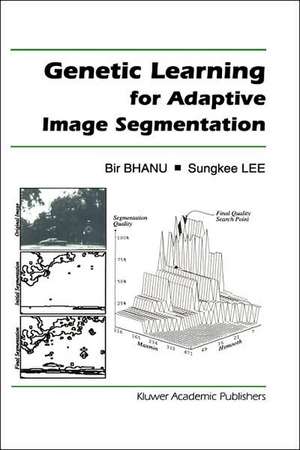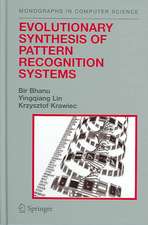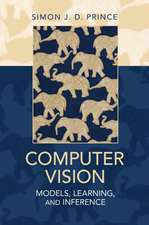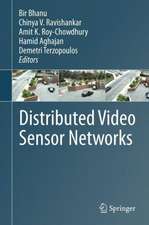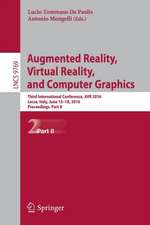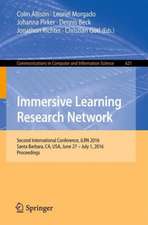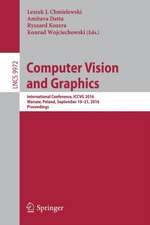Genetic Learning for Adaptive Image Segmentation: The Springer International Series in Engineering and Computer Science, cartea 287
Autor Bir Bhanu, Sungkee Leeen Limba Engleză Hardback – 30 sep 1994
Genetic Learning for Adaptive Image Segmentation presents the first closed-loop image segmentation system that incorporates genetic and other algorithms to adapt the segmentation process to changes in image characteristics caused by variable environmental conditions, such as time of day, time of year, weather, etc. Image segmentation performance is evaluated using multiple measures of segmentation quality. These quality measures include global characteristics of the entire image as well as local features of individual object regions in the image.
This adaptive image segmentation system provides continuous adaptation to normal environmental variations, exhibits learning capabilities, and provides robust performance when interacting with a dynamic environment. This research is directed towards adapting the performance of a well known existing segmentation algorithm (Phoenix) across a wide variety of environmental conditions which cause changes in the image characteristics. The book presents a large number of experimental results and compares performance with standard techniques used in computer vision for both consistency and quality of segmentation results. These results demonstrate, (a) the ability to adapt the segmentation performance in both indoor and outdoor color imagery, and (b) that learning from experience can be used to improve the segmentation performance over time.
| Toate formatele și edițiile | Preț | Express |
|---|---|---|
| Paperback (1) | 986.99 lei 6-8 săpt. | |
| Springer Us – 22 dec 2012 | 986.99 lei 6-8 săpt. | |
| Hardback (1) | 993.28 lei 6-8 săpt. | |
| Springer Us – 30 sep 1994 | 993.28 lei 6-8 săpt. |
Din seria The Springer International Series in Engineering and Computer Science
- 24%
 Preț: 1041.98 lei
Preț: 1041.98 lei - 20%
 Preț: 643.50 lei
Preț: 643.50 lei - 18%
 Preț: 1225.62 lei
Preț: 1225.62 lei - 18%
 Preț: 965.02 lei
Preț: 965.02 lei - 20%
 Preț: 646.12 lei
Preț: 646.12 lei - 18%
 Preț: 948.79 lei
Preț: 948.79 lei - 20%
 Preț: 646.62 lei
Preț: 646.62 lei - 15%
 Preț: 637.46 lei
Preț: 637.46 lei - 20%
 Preț: 643.83 lei
Preț: 643.83 lei - 18%
 Preț: 949.23 lei
Preț: 949.23 lei - 20%
 Preț: 644.48 lei
Preț: 644.48 lei - 20%
 Preț: 994.92 lei
Preț: 994.92 lei - 20%
 Preț: 645.97 lei
Preț: 645.97 lei - 18%
 Preț: 946.87 lei
Preț: 946.87 lei - 20%
 Preț: 995.57 lei
Preț: 995.57 lei - 18%
 Preț: 956.99 lei
Preț: 956.99 lei - 20%
 Preț: 644.98 lei
Preț: 644.98 lei - 15%
 Preț: 649.54 lei
Preț: 649.54 lei - 18%
 Preț: 950.21 lei
Preț: 950.21 lei - 18%
 Preț: 1221.38 lei
Preț: 1221.38 lei - 18%
 Preț: 957.62 lei
Preț: 957.62 lei - 15%
 Preț: 643.99 lei
Preț: 643.99 lei - 18%
 Preț: 948.47 lei
Preț: 948.47 lei - 18%
 Preț: 947.35 lei
Preț: 947.35 lei - 20%
 Preț: 1284.65 lei
Preț: 1284.65 lei - 20%
 Preț: 1628.31 lei
Preț: 1628.31 lei - 20%
 Preț: 1285.78 lei
Preț: 1285.78 lei
Preț: 993.28 lei
Preț vechi: 1241.59 lei
-20% Nou
Puncte Express: 1490
Preț estimativ în valută:
190.06€ • 198.46$ • 156.95£
190.06€ • 198.46$ • 156.95£
Carte tipărită la comandă
Livrare economică 15-29 aprilie
Preluare comenzi: 021 569.72.76
Specificații
ISBN-13: 9780792394914
ISBN-10: 0792394917
Pagini: 271
Ilustrații: XIX, 271 p.
Dimensiuni: 155 x 235 x 18 mm
Greutate: 0.59 kg
Ediția:1994
Editura: Springer Us
Colecția Springer
Seria The Springer International Series in Engineering and Computer Science
Locul publicării:New York, NY, United States
ISBN-10: 0792394917
Pagini: 271
Ilustrații: XIX, 271 p.
Dimensiuni: 155 x 235 x 18 mm
Greutate: 0.59 kg
Ediția:1994
Editura: Springer Us
Colecția Springer
Seria The Springer International Series in Engineering and Computer Science
Locul publicării:New York, NY, United States
Public țintă
ResearchCuprins
1 Introduction.- 2 Image Segmentation Techniques.- 3 Segmentation as an Optimization Problem.- 4 Baseline Adaptive Image Segmentation Using a Genetic Algorithm.- 5 Basic Experimental Results – Indoor Imagery.- 6 Basic Experimental Results – Outdoor Imagery.- 7 Evaluating the Effectiveness of the Baseline Technique – Further experiments.- 8 Hybrid Search Scheme for Adaptive Image Segmentation.- 9 Simultaneous Optimization of Global and Local Evaluation Measures.- 10 Summary.- References.
